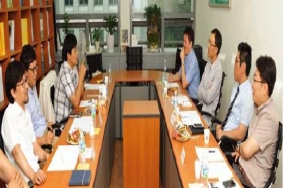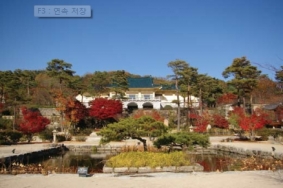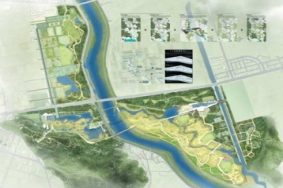-
 한국조경의 오늘을 진단하다(2)-지상좌담: 탈 토건시대의 조경
한국조경의 오늘을 진단하다(2)-지상좌담: 탈 토건시대의 조경
조경의 봄날은 가고 있는가어제 오늘의 일은 아니지만, 조경의 총 수주물량이 전성기의 반토막 이하로 줄고, 실제 군소업체의 체감물량은 이의 또한 반 이하로 줄어들어 가고 있다. 앞으로의 전망 역시 단기간 내의 만회를 기대하기 어려운 현시점에서 조경교육의 일선을 담당하고 있는 우리 교육자들의 대부분은 재학생, 졸업생, 동료조경인 모두에게 연대책임을 느끼지 않을 수 없다. 이런 와중에 인접분야로부터 영역침범의 파도는 점점 전방위적으로 밀려들어 오고 있다. 조경분야가 이 땅에 성립된 이래 반세기에 육박하는 현시점에서 타 분야로부터 사실 이런 강도의 구애(求愛)는 받아본 적이 없었다. 우리 입장에서 볼 때는 상당 부분 명백한 침략적 행위일 수 있고 이에 대한 상시적인 경계와 사안별 방어도 필요하지만 이를 역설적으로 생각할 수도 있겠다는 생각이 든다. 즉, 그들의 이런 행보는 우리가 못 보는 조경의 미래산업적 가치를 그들의 눈으로 포착하고 평가한 것으로 볼 수도 있으며 그만큼 우리 분야의 잠재력이 높다는 것을 방증해주는 것으로 이런 차원에서 우리 분야의 새로운 가능성을 발견할 수도 있다. 다시 말해, 위기를 기회로 역지사지(易地思之)해 새로운 확장적 전략을 모색할 수 있으리라는 것이다. 거시적 여건을 보더라도, 우리가 하루하루 체감하는 기후급변과 환경재앙에 따르는 녹색환경 요구도의 증가, 보편적 복지 증진요구에 따르는 공공공간의 확장 가능성, 하드사이언스 위주의 산업구조에서 소프트한 문화 위주 산업구조로의 전환 추세 등 시대적 흐름의 큰 방향을 볼 때도, 녹색환경과 인문환경을 강화해 나갈 수 있는 조경의 역할을 장기적으로 거스를 수 없을 것으로 판단된다.
-
 한국조경의 오늘을 진단하다(2)-지상좌담: 조경의 미래
한국조경의 오늘을 진단하다(2)-지상좌담: 조경의 미래
지난번 3040 집담회를 즐겁게 읽었습니다. 토론에 참가한 사람 모두 조경에 대한 사랑이 절절하다는 걸 알 수 있었습니다. 그들보다 좀 더 나이가 많은 위 세대로서 이런 상황이 초래된 것에 대해 책임이 있는 까닭에 매우 부끄럽기도 하고 또 반성도 되었습니다. 대부분 3040 토론자들의 의견에 동조하는 바이고, 동료의 한 사람으로서 그들과 걱정을 같이 하고 있다는 것을 말씀드리고 싶습니다. 이왕에 지상 토론의 기회가 주어졌으니 지난번 3040 집담회의 내용에 몇 가지 동의하는 사항에는 덧붙일 말씀을 드리고 싶고, 동의하지 않는 사항에 대해서는 좀 다른 의견을 말해보고자 합니다. 지면에 담기는 제 의견들이 조경의 미래를 걱정하는 분들에게 조금이라도 위로나 도움이 되었으면 하고 바라고 있습니다.
-
 한국조경의 오늘을 진단하다(2)-지상좌담: 조경분양의 과거, 현재 그리고 미래
한국조경의 오늘을 진단하다(2)-지상좌담: 조경분양의 과거, 현재 그리고 미래
조경의 과거 - 고난과 역경, 그리고 전쟁, 새마을운동조경의 역사는 우리나라 경제발전과 발을 맞추며 동일한 성장과정을 겪어왔다고 해도 과언이 아닙니다. 1910년에 한일합방으로 일본의 통치를 받으며 35년간 고난의 역사를 쓰다가 1945년, 해방의 기쁨을 누리기도 전인 1950년 6월 25일 새벽, 북한이 침략을 가해 6.25동란이 일어났습니다. 단일민족끼리의 다른 이념 때문에 1953년 휴전을 하기 전까지 전쟁의 소용돌이를 겪고 난 후, 우리민족의 마음속에는 오직 먹고 사는 것 외에는 신경 쓸 힘이 없었습니다. 이러한 시기에 박정희 대통령은 근면, 자조, 협동의 정신을 가지고 어제보다 나은 내일을 만들려는 기본이념으로 1970년에 새마을운동을 제창했습니다. 이는 국민개개인의 생활향상과 자유로운 성장은 물론, 국가의 발전과 국민의 중흥을 이룩하려는 지역사회개발운동이며, 이를 통해 사회혁신운동을 제창하며 경제발전의 시동을 걸게 되었던 것입니다.
이 운동을 계기로 국토개발이 엄청난 속도로 진행되면서 1973년 영남대학교와 서울대학교에 조경학과가 생기며 조경이 태동되었습니다. 처음 만들어진다는 것은 완벽하고 철저하게 준비되어진 것이 아닌, 필요성으로 급조된 것이므로 체계가 없고 자원도 없이 만들어졌다고 해도 과언이 아닐 것입니다. 그런 역사적 배경을 가진 조경의 탄생은 결국 국가개발과 밀접하게 발전과정을 겪게 되면서 조경의 주도적, 체계적, 논리적 역사를 써온 것이 아니라 국가발전이나 경제성장에 편승하여 양적성장을 해오게 된 것입니다. 그렇기 때문에 조경역사의 과거를 먼저 살펴보아야 현재를 이해하고 미래를 예측하고 준비할 수 있을 것이라 생각합니다.
-
 한국조경의 오늘을 진단하다(1)-3040 집담회
한국조경의 오늘을 진단하다(1)-3040 집담회
<환경과조경>에서는 창사 30주년을 맞이하여 ‘한국조경의 오늘을 진단하다’라는 타이틀로 연속특별기획을 진행한다. 조경분야의 한 단계 성장을 위한 다양한 자성과 성찰의 계기를 마련하고자 3개월여에 걸쳐 국내외 실무자들이 느끼는 한국조경의 위상 및 문제점, 인근분야가 생각하는 조경분야의 문제점 등에 대해서 다각적으로 논의를 진행하고, 그동안 모아진 다양한 논의들을 바탕으로 공개토론회를 개최하여 현실적인 대안 제시 및 향후 한국조경이 가질 수 있는 가능성과 비전을 논의할 예정이다.
연속특별기획 ‘한국조경의 오늘을 진단하다’ 그 첫 번째, ‘3040 집담회’가 지난 7월 13일(금) 오후 3시 30분부터 약 3시간에 걸쳐 한국과학기술회관 608호 (사)한국조경사회 사무국에서 진행되었다. 실무에서 가장 왕성한 활동을 하고 있는 30대 후반에서 40대 초반의 조경인들이 초대되어 기성세대와 신세대를 아우르는 중간관리자로서의 입장을 대변하여 조경분야의 문제들을 가감 없이 털어놓았다.
백정희 편집장<환경과조경> 전무이사은 “한국조경은 큰 위기에 봉착해 있지만 분명히 기회가 함께 존재할 것이다. 이에 조경분야의 여러 세대가 공감할 수 있는 고민을 끌어내어 키워드로 도출하고, 그에 따른 더 많은 대안과 비전을 우리 스스로 찾아볼 수 있는 연속기획이 되었으면 한다.”고 기획의도를 전달했다. 이어 “한국조경을 진단하는 그 시작점으로 엔지니어링, 설계, 시공 등 각계의 실무자들의 고민을 모아서 대안이나 비전의 제시에 앞서 문제점을 도출하고 이해하는 자리로 삼고자 자리를 마련했다.”고 밝히며 집담회를 시작했다.
일시_ 2012년 7월 13일(금)장소 _ 한국과학기술회관 608호 (사)한국조경사회 사무국주최 _ 월간 <환경과조경>참석자김민성·(주)포스코엔지니어링 차장김지현·동부엔지니어링(주) 차장백정희·<환경과조경> 편집장 겸 전무이사송영탁·(주)그룹한 어소시에이트 부소장안명준·(재)한국조경발전재단 사무국장염인석·서울대 환경대학원 환경계획연구소 연구원유승렬·(주)대경E&C 부장한성일·(주)장원조경 부장(이상 가나다 순)
-
 한국 조경 그리고 <환경과조경> 30년의 기억
한국 조경 그리고 <환경과조경> 30년의 기억
Korean Landscape Architecture & ELA’s Memory of the 30 Years지난 1982년 한국 최초의 조경잡지로 첫 발을 내딛은 월간 <환경과조경>이 7월 1일로 창간30주년을 맞이했다. 그동안 수많은 어려움 가운데서도 한국 조경의 역사와 함께 성장하며 한국의 대표 조경언론으로 자리매김할 수 있었던 것은 독자 여러분의 관심과 사랑, 그리고 격려 덕분이었음에 깊이 감사드린다.창간30주년을 맞이하여 본지 편집부에서는 지난 30년의 기록을 되짚어 한국 조경의 발전과 함께 걸어온 발자취를 되돌아보고자 조경가들을 대상으로 설문조사(조사대상 200명 중 150명 회신, 각 연대별 5개씩 복수응답)를 실시하였다.본지가 창간되던 당시만 해도 건물 주변의 식재에 머물던 조경설계는 30년이 지난 지금 환경이 주목받는 시대의 도래와 더불어 도시공간의 틀을 바로잡고 국토환경을 치유하는데 앞장설 만큼 크게 성장하였다.이에 이번 설문조사는 지난 30년 동안 <환경과조경>에 소개되었던 작품들을 대상으로 1980년대, 1990대, 2000년대로 나누어 각 시대별로 주요 작품들과 공모전을 비롯한 설계이슈를 돌아봄으로써 한국 조경설계의 흐름과 성과 등을 알아보고자 기획되었다. 비록 이번 조사가 지난 30년간의 기록과 변화를 온전히 객관적으로 담아냈다고는 감히 이야기 할 순 없겠지만, 앞으로 한국조경의 발전을 견인할 풍부한 조경 담론을 생성하는 귀중한 자료가 되었으면 하는 바람이다.
ELA, which was first published in 1982, is enjoying its 30th anniversary this year. To celebrate this significant moment and provide some valuable information on the history of the Korean landscape architecture for the last 30 years, the editorial department of ELA conducted a survey of practitioners in the field of landscape architectural design.The Korean landscape architecture, which, in 1980s, was in its early stage of development focusing on planting trees and flowers around buildings, has witnessed a remarkable growth, now presenting a direction for the establishment of urban environment and restoring the natural environment of the country.The survey is designed to select some of the most important landscape architectura l works and design competitions with periodic categorization of 1980s, 1990s, and 2000s, with an in-depth report on the history and achievements of the industry. The findings of the survey will hopefully contribute to creating a further discussion on the constant progress of the landscape architecture in Korea.
-
 조경가들이 뽑은 시대별 작품 베스트
조경가들이 뽑은 시대별 작품 베스트
Best Works of Each Time, Selected by Landscape Architects
1982-19891. 올림픽공원 143명2. 파리공원 128명3. 서울대공원 98명4. 한국종합무역센터 96명5. 아시아공원 61명
1990-19991. 일산 호수공원 117명2. 길동자연생태공원 94명3. 양재천 90명4. 여의도공원 83명5. 희원 75명
2000-20051. 선유도공원 145명2. 서울숲 137명3. 월드컵공원 133명4. 청계천 111명5. ASEM 한국종합무역센터 62명
2006-20121. 북서울 꿈의 숲 124명2. 광화문광장 107명3. 서서울호수공원 98명4. 울산대공원 66명5. 국립중앙박물관 54명
-
 조경가들이 뽑은 시대별 설계 이슈 베스트
조경가들이 뽑은 시대별 설계 이슈 베스트
Best Design Issue of Each Time, Selected by Landscape Architects1982-19891. 한강종합개발계획 마스터플랜 128명2. 미사리 조정카누경기장 개발사업 65명3. 도투락월드 기본계획 및 설계 60명4. 내장산 사계절 관광 개발 기본계획 47명5. 한국과학기술원 캠퍼스 기본계획 38명
1990-19991. 선유도 공원화사업설계 현상공모 133명2. 여의도광장 공원화 126명3. 마을마당(쌈지공원)조성 기본계획 88명4. 용산가족공원 현상공모 84명5. 국립중앙박물관 국제설계경기 79명
2000-20091. 순천만국제정원박람회 마스터플랜 공모 101명2. 서울숲 설계공모 90명3. 행정중심복합도시 중앙녹지공간 국제설계공모 84명4. 서울시청 앞 광장조성 설계공모 82명5. 강북대형공원 마스터플랜 국제현상설계 63명
2010-20121. 용산공원조성 국제설계공모 144명2. 동탄2신도시 워터프론트 설계공모 104명3. 보금자리주택지구 조경설계공모(세곡/내곡 등) 81명4. 송산그린시티 개발사업 철새서식지 설계공모 77명5. 위례신도시 택지개발지구 조경설계공모 69명
-
 한국 조경 그리고 <환경과조경> 30년의 기억
한국 조경 그리고 <환경과조경> 30년의 기억
Korean Landscape Architecture & ELA’s Memory of the 30 Years지난 1982년 한국 최초의 조경잡지로 첫 발을 내딛은 월간 <환경과조경>이 7월 1일로 창간30주년을 맞이했다. 그동안 수많은 어려움 가운데서도 한국 조경의 역사와 함께 성장하며 한국의 대표 조경언론으로 자리매김할 수 있었던 것은 독자 여러분의 관심과 사랑, 그리고 격려 덕분이었음에 깊이 감사드린다.창간30주년을 맞이하여 본지 편집부에서는 지난 30년의 기록을 되짚어 한국 조경의 발전과 함께 걸어온 발자취를 되돌아보고자 조경가들을 대상으로 설문조사(조사대상 200명 중 150명 회신, 각 연대별 5개씩 복수응답)를 실시하였다.본지가 창간되던 당시만 해도 건물 주변의 식재에 머물던 조경설계는 30년이 지난 지금 환경이 주목받는 시대의 도래와 더불어 도시공간의 틀을 바로잡고 국토환경을 치유하는데 앞장설 만큼 크게 성장하였다.이에 이번 설문조사는 지난 30년 동안 <환경과조경>에 소개되었던 작품들을 대상으로 1980년대, 1990대, 2000년대로 나누어 각 시대별로 주요 작품들과 공모전을 비롯한 설계이슈를 돌아봄으로써 한국 조경설계의 흐름과 성과 등을 알아보고자 기획되었다. 비록 이번 조사가 지난 30년간의 기록과 변화를 온전히 객관적으로 담아냈다고는 감히 이야기 할 순 없겠지만, 앞으로 한국조경의 발전을 견인할 풍부한 조경 담론을 생성하는 귀중한 자료가 되었으면 하는 바람이다.
ELA, which was first published in 1982, is enjoying its 30th anniversary this year. To celebrate this significant moment and provide some valuable information on the history of the Korean landscape architecture for the last 30 years, the editorial department of ELA conducted a survey of practitioners in the field of landscape architectural design.The Korean landscape architecture, which, in 1980s, was in its early stage of development focusing on planting trees and flowers around buildings, has witnessed a remarkable growth, now presenting a direction for the establishment of urban environment and restoring the natural environment of the country.The survey is designed to select some of the most important landscape architectura l works and design competitions with periodic categorization of 1980s, 1990s, and 2000s, with an in-depth report on the history and achievements of the industry. The findings of the survey will hopefully contribute to creating a further discussion on the constant progress of the landscape architecture in Korea.
-
 창간30주년 <환경과조경>에 보내는 축하메시지
창간30주년 <환경과조경>에 보내는 축하메시지
지난 30년 동안 현대조경의 푸르른 역사와 함께 성장해 온 <환경과조경>이 창간30주년을 맞이했다. 그동안 아낌없는 사랑과 관심을 보여주신 독자분들께 진심 어린 감사를 드리며,앞으로 조경분야의 소통과 화합을 위해 더욱 노력할 것을 약속드린다. 다시 한번 응원과 축하메시지를 보내주신 독자분들게 감사드린다.
-
 <환경과조경> 30년이 걸어온 발자취
<환경과조경> 30년이 걸어온 발자취
 한국조경의 오늘을 진단하다(2)-지상좌담: 탈 토건시대의 조경
조경의 봄날은 가고 있는가어제 오늘의 일은 아니지만, 조경의 총 수주물량이 전성기의 반토막 이하로 줄고, 실제 군소업체의 체감물량은 이의 또한 반 이하로 줄어들어 가고 있다. 앞으로의 전망 역시 단기간 내의 만회를 기대하기 어려운 현시점에서 조경교육의 일선을 담당하고 있는 우리 교육자들의 대부분은 재학생, 졸업생, 동료조경인 모두에게 연대책임을 느끼지 않을 수 없다. 이런 와중에 인접분야로부터 영역침범의 파도는 점점 전방위적으로 밀려들어 오고 있다. 조경분야가 이 땅에 성립된 이래 반세기에 육박하는 현시점에서 타 분야로부터 사실 이런 강도의 구애(求愛)는 받아본 적이 없었다. 우리 입장에서 볼 때는 상당 부분 명백한 침략적 행위일 수 있고 이에 대한 상시적인 경계와 사안별 방어도 필요하지만 이를 역설적으로 생각할 수도 있겠다는 생각이 든다. 즉, 그들의 이런 행보는 우리가 못 보는 조경의 미래산업적 가치를 그들의 눈으로 포착하고 평가한 것으로 볼 수도 있으며 그만큼 우리 분야의 잠재력이 높다는 것을 방증해주는 것으로 이런 차원에서 우리 분야의 새로운 가능성을 발견할 수도 있다. 다시 말해, 위기를 기회로 역지사지(易地思之)해 새로운 확장적 전략을 모색할 수 있으리라는 것이다. 거시적 여건을 보더라도, 우리가 하루하루 체감하는 기후급변과 환경재앙에 따르는 녹색환경 요구도의 증가, 보편적 복지 증진요구에 따르는 공공공간의 확장 가능성, 하드사이언스 위주의 산업구조에서 소프트한 문화 위주 산업구조로의 전환 추세 등 시대적 흐름의 큰 방향을 볼 때도, 녹색환경과 인문환경을 강화해 나갈 수 있는 조경의 역할을 장기적으로 거스를 수 없을 것으로 판단된다.
한국조경의 오늘을 진단하다(2)-지상좌담: 탈 토건시대의 조경
조경의 봄날은 가고 있는가어제 오늘의 일은 아니지만, 조경의 총 수주물량이 전성기의 반토막 이하로 줄고, 실제 군소업체의 체감물량은 이의 또한 반 이하로 줄어들어 가고 있다. 앞으로의 전망 역시 단기간 내의 만회를 기대하기 어려운 현시점에서 조경교육의 일선을 담당하고 있는 우리 교육자들의 대부분은 재학생, 졸업생, 동료조경인 모두에게 연대책임을 느끼지 않을 수 없다. 이런 와중에 인접분야로부터 영역침범의 파도는 점점 전방위적으로 밀려들어 오고 있다. 조경분야가 이 땅에 성립된 이래 반세기에 육박하는 현시점에서 타 분야로부터 사실 이런 강도의 구애(求愛)는 받아본 적이 없었다. 우리 입장에서 볼 때는 상당 부분 명백한 침략적 행위일 수 있고 이에 대한 상시적인 경계와 사안별 방어도 필요하지만 이를 역설적으로 생각할 수도 있겠다는 생각이 든다. 즉, 그들의 이런 행보는 우리가 못 보는 조경의 미래산업적 가치를 그들의 눈으로 포착하고 평가한 것으로 볼 수도 있으며 그만큼 우리 분야의 잠재력이 높다는 것을 방증해주는 것으로 이런 차원에서 우리 분야의 새로운 가능성을 발견할 수도 있다. 다시 말해, 위기를 기회로 역지사지(易地思之)해 새로운 확장적 전략을 모색할 수 있으리라는 것이다. 거시적 여건을 보더라도, 우리가 하루하루 체감하는 기후급변과 환경재앙에 따르는 녹색환경 요구도의 증가, 보편적 복지 증진요구에 따르는 공공공간의 확장 가능성, 하드사이언스 위주의 산업구조에서 소프트한 문화 위주 산업구조로의 전환 추세 등 시대적 흐름의 큰 방향을 볼 때도, 녹색환경과 인문환경을 강화해 나갈 수 있는 조경의 역할을 장기적으로 거스를 수 없을 것으로 판단된다. 한국조경의 오늘을 진단하다(2)-지상좌담: 조경의 미래
지난번 3040 집담회를 즐겁게 읽었습니다. 토론에 참가한 사람 모두 조경에 대한 사랑이 절절하다는 걸 알 수 있었습니다. 그들보다 좀 더 나이가 많은 위 세대로서 이런 상황이 초래된 것에 대해 책임이 있는 까닭에 매우 부끄럽기도 하고 또 반성도 되었습니다. 대부분 3040 토론자들의 의견에 동조하는 바이고, 동료의 한 사람으로서 그들과 걱정을 같이 하고 있다는 것을 말씀드리고 싶습니다. 이왕에 지상 토론의 기회가 주어졌으니 지난번 3040 집담회의 내용에 몇 가지 동의하는 사항에는 덧붙일 말씀을 드리고 싶고, 동의하지 않는 사항에 대해서는 좀 다른 의견을 말해보고자 합니다. 지면에 담기는 제 의견들이 조경의 미래를 걱정하는 분들에게 조금이라도 위로나 도움이 되었으면 하고 바라고 있습니다.
한국조경의 오늘을 진단하다(2)-지상좌담: 조경의 미래
지난번 3040 집담회를 즐겁게 읽었습니다. 토론에 참가한 사람 모두 조경에 대한 사랑이 절절하다는 걸 알 수 있었습니다. 그들보다 좀 더 나이가 많은 위 세대로서 이런 상황이 초래된 것에 대해 책임이 있는 까닭에 매우 부끄럽기도 하고 또 반성도 되었습니다. 대부분 3040 토론자들의 의견에 동조하는 바이고, 동료의 한 사람으로서 그들과 걱정을 같이 하고 있다는 것을 말씀드리고 싶습니다. 이왕에 지상 토론의 기회가 주어졌으니 지난번 3040 집담회의 내용에 몇 가지 동의하는 사항에는 덧붙일 말씀을 드리고 싶고, 동의하지 않는 사항에 대해서는 좀 다른 의견을 말해보고자 합니다. 지면에 담기는 제 의견들이 조경의 미래를 걱정하는 분들에게 조금이라도 위로나 도움이 되었으면 하고 바라고 있습니다. 한국조경의 오늘을 진단하다(2)-지상좌담: 조경분양의 과거, 현재 그리고 미래
조경의 과거 - 고난과 역경, 그리고 전쟁, 새마을운동조경의 역사는 우리나라 경제발전과 발을 맞추며 동일한 성장과정을 겪어왔다고 해도 과언이 아닙니다. 1910년에 한일합방으로 일본의 통치를 받으며 35년간 고난의 역사를 쓰다가 1945년, 해방의 기쁨을 누리기도 전인 1950년 6월 25일 새벽, 북한이 침략을 가해 6.25동란이 일어났습니다. 단일민족끼리의 다른 이념 때문에 1953년 휴전을 하기 전까지 전쟁의 소용돌이를 겪고 난 후, 우리민족의 마음속에는 오직 먹고 사는 것 외에는 신경 쓸 힘이 없었습니다. 이러한 시기에 박정희 대통령은 근면, 자조, 협동의 정신을 가지고 어제보다 나은 내일을 만들려는 기본이념으로 1970년에 새마을운동을 제창했습니다. 이는 국민개개인의 생활향상과 자유로운 성장은 물론, 국가의 발전과 국민의 중흥을 이룩하려는 지역사회개발운동이며, 이를 통해 사회혁신운동을 제창하며 경제발전의 시동을 걸게 되었던 것입니다. 이 운동을 계기로 국토개발이 엄청난 속도로 진행되면서 1973년 영남대학교와 서울대학교에 조경학과가 생기며 조경이 태동되었습니다. 처음 만들어진다는 것은 완벽하고 철저하게 준비되어진 것이 아닌, 필요성으로 급조된 것이므로 체계가 없고 자원도 없이 만들어졌다고 해도 과언이 아닐 것입니다. 그런 역사적 배경을 가진 조경의 탄생은 결국 국가개발과 밀접하게 발전과정을 겪게 되면서 조경의 주도적, 체계적, 논리적 역사를 써온 것이 아니라 국가발전이나 경제성장에 편승하여 양적성장을 해오게 된 것입니다. 그렇기 때문에 조경역사의 과거를 먼저 살펴보아야 현재를 이해하고 미래를 예측하고 준비할 수 있을 것이라 생각합니다.
한국조경의 오늘을 진단하다(2)-지상좌담: 조경분양의 과거, 현재 그리고 미래
조경의 과거 - 고난과 역경, 그리고 전쟁, 새마을운동조경의 역사는 우리나라 경제발전과 발을 맞추며 동일한 성장과정을 겪어왔다고 해도 과언이 아닙니다. 1910년에 한일합방으로 일본의 통치를 받으며 35년간 고난의 역사를 쓰다가 1945년, 해방의 기쁨을 누리기도 전인 1950년 6월 25일 새벽, 북한이 침략을 가해 6.25동란이 일어났습니다. 단일민족끼리의 다른 이념 때문에 1953년 휴전을 하기 전까지 전쟁의 소용돌이를 겪고 난 후, 우리민족의 마음속에는 오직 먹고 사는 것 외에는 신경 쓸 힘이 없었습니다. 이러한 시기에 박정희 대통령은 근면, 자조, 협동의 정신을 가지고 어제보다 나은 내일을 만들려는 기본이념으로 1970년에 새마을운동을 제창했습니다. 이는 국민개개인의 생활향상과 자유로운 성장은 물론, 국가의 발전과 국민의 중흥을 이룩하려는 지역사회개발운동이며, 이를 통해 사회혁신운동을 제창하며 경제발전의 시동을 걸게 되었던 것입니다. 이 운동을 계기로 국토개발이 엄청난 속도로 진행되면서 1973년 영남대학교와 서울대학교에 조경학과가 생기며 조경이 태동되었습니다. 처음 만들어진다는 것은 완벽하고 철저하게 준비되어진 것이 아닌, 필요성으로 급조된 것이므로 체계가 없고 자원도 없이 만들어졌다고 해도 과언이 아닐 것입니다. 그런 역사적 배경을 가진 조경의 탄생은 결국 국가개발과 밀접하게 발전과정을 겪게 되면서 조경의 주도적, 체계적, 논리적 역사를 써온 것이 아니라 국가발전이나 경제성장에 편승하여 양적성장을 해오게 된 것입니다. 그렇기 때문에 조경역사의 과거를 먼저 살펴보아야 현재를 이해하고 미래를 예측하고 준비할 수 있을 것이라 생각합니다. 한국조경의 오늘을 진단하다(1)-3040 집담회
<환경과조경>에서는 창사 30주년을 맞이하여 ‘한국조경의 오늘을 진단하다’라는 타이틀로 연속특별기획을 진행한다. 조경분야의 한 단계 성장을 위한 다양한 자성과 성찰의 계기를 마련하고자 3개월여에 걸쳐 국내외 실무자들이 느끼는 한국조경의 위상 및 문제점, 인근분야가 생각하는 조경분야의 문제점 등에 대해서 다각적으로 논의를 진행하고, 그동안 모아진 다양한 논의들을 바탕으로 공개토론회를 개최하여 현실적인 대안 제시 및 향후 한국조경이 가질 수 있는 가능성과 비전을 논의할 예정이다. 연속특별기획 ‘한국조경의 오늘을 진단하다’ 그 첫 번째, ‘3040 집담회’가 지난 7월 13일(금) 오후 3시 30분부터 약 3시간에 걸쳐 한국과학기술회관 608호 (사)한국조경사회 사무국에서 진행되었다. 실무에서 가장 왕성한 활동을 하고 있는 30대 후반에서 40대 초반의 조경인들이 초대되어 기성세대와 신세대를 아우르는 중간관리자로서의 입장을 대변하여 조경분야의 문제들을 가감 없이 털어놓았다. 백정희 편집장<환경과조경> 전무이사은 “한국조경은 큰 위기에 봉착해 있지만 분명히 기회가 함께 존재할 것이다. 이에 조경분야의 여러 세대가 공감할 수 있는 고민을 끌어내어 키워드로 도출하고, 그에 따른 더 많은 대안과 비전을 우리 스스로 찾아볼 수 있는 연속기획이 되었으면 한다.”고 기획의도를 전달했다. 이어 “한국조경을 진단하는 그 시작점으로 엔지니어링, 설계, 시공 등 각계의 실무자들의 고민을 모아서 대안이나 비전의 제시에 앞서 문제점을 도출하고 이해하는 자리로 삼고자 자리를 마련했다.”고 밝히며 집담회를 시작했다. 일시_ 2012년 7월 13일(금)장소 _ 한국과학기술회관 608호 (사)한국조경사회 사무국주최 _ 월간 <환경과조경>참석자김민성·(주)포스코엔지니어링 차장김지현·동부엔지니어링(주) 차장백정희·<환경과조경> 편집장 겸 전무이사송영탁·(주)그룹한 어소시에이트 부소장안명준·(재)한국조경발전재단 사무국장염인석·서울대 환경대학원 환경계획연구소 연구원유승렬·(주)대경E&C 부장한성일·(주)장원조경 부장(이상 가나다 순)
한국조경의 오늘을 진단하다(1)-3040 집담회
<환경과조경>에서는 창사 30주년을 맞이하여 ‘한국조경의 오늘을 진단하다’라는 타이틀로 연속특별기획을 진행한다. 조경분야의 한 단계 성장을 위한 다양한 자성과 성찰의 계기를 마련하고자 3개월여에 걸쳐 국내외 실무자들이 느끼는 한국조경의 위상 및 문제점, 인근분야가 생각하는 조경분야의 문제점 등에 대해서 다각적으로 논의를 진행하고, 그동안 모아진 다양한 논의들을 바탕으로 공개토론회를 개최하여 현실적인 대안 제시 및 향후 한국조경이 가질 수 있는 가능성과 비전을 논의할 예정이다. 연속특별기획 ‘한국조경의 오늘을 진단하다’ 그 첫 번째, ‘3040 집담회’가 지난 7월 13일(금) 오후 3시 30분부터 약 3시간에 걸쳐 한국과학기술회관 608호 (사)한국조경사회 사무국에서 진행되었다. 실무에서 가장 왕성한 활동을 하고 있는 30대 후반에서 40대 초반의 조경인들이 초대되어 기성세대와 신세대를 아우르는 중간관리자로서의 입장을 대변하여 조경분야의 문제들을 가감 없이 털어놓았다. 백정희 편집장<환경과조경> 전무이사은 “한국조경은 큰 위기에 봉착해 있지만 분명히 기회가 함께 존재할 것이다. 이에 조경분야의 여러 세대가 공감할 수 있는 고민을 끌어내어 키워드로 도출하고, 그에 따른 더 많은 대안과 비전을 우리 스스로 찾아볼 수 있는 연속기획이 되었으면 한다.”고 기획의도를 전달했다. 이어 “한국조경을 진단하는 그 시작점으로 엔지니어링, 설계, 시공 등 각계의 실무자들의 고민을 모아서 대안이나 비전의 제시에 앞서 문제점을 도출하고 이해하는 자리로 삼고자 자리를 마련했다.”고 밝히며 집담회를 시작했다. 일시_ 2012년 7월 13일(금)장소 _ 한국과학기술회관 608호 (사)한국조경사회 사무국주최 _ 월간 <환경과조경>참석자김민성·(주)포스코엔지니어링 차장김지현·동부엔지니어링(주) 차장백정희·<환경과조경> 편집장 겸 전무이사송영탁·(주)그룹한 어소시에이트 부소장안명준·(재)한국조경발전재단 사무국장염인석·서울대 환경대학원 환경계획연구소 연구원유승렬·(주)대경E&C 부장한성일·(주)장원조경 부장(이상 가나다 순) 한국 조경 그리고 <환경과조경> 30년의 기억
Korean Landscape Architecture & ELA’s Memory of the 30 Years지난 1982년 한국 최초의 조경잡지로 첫 발을 내딛은 월간 <환경과조경>이 7월 1일로 창간30주년을 맞이했다. 그동안 수많은 어려움 가운데서도 한국 조경의 역사와 함께 성장하며 한국의 대표 조경언론으로 자리매김할 수 있었던 것은 독자 여러분의 관심과 사랑, 그리고 격려 덕분이었음에 깊이 감사드린다.창간30주년을 맞이하여 본지 편집부에서는 지난 30년의 기록을 되짚어 한국 조경의 발전과 함께 걸어온 발자취를 되돌아보고자 조경가들을 대상으로 설문조사(조사대상 200명 중 150명 회신, 각 연대별 5개씩 복수응답)를 실시하였다.본지가 창간되던 당시만 해도 건물 주변의 식재에 머물던 조경설계는 30년이 지난 지금 환경이 주목받는 시대의 도래와 더불어 도시공간의 틀을 바로잡고 국토환경을 치유하는데 앞장설 만큼 크게 성장하였다.이에 이번 설문조사는 지난 30년 동안 <환경과조경>에 소개되었던 작품들을 대상으로 1980년대, 1990대, 2000년대로 나누어 각 시대별로 주요 작품들과 공모전을 비롯한 설계이슈를 돌아봄으로써 한국 조경설계의 흐름과 성과 등을 알아보고자 기획되었다. 비록 이번 조사가 지난 30년간의 기록과 변화를 온전히 객관적으로 담아냈다고는 감히 이야기 할 순 없겠지만, 앞으로 한국조경의 발전을 견인할 풍부한 조경 담론을 생성하는 귀중한 자료가 되었으면 하는 바람이다. ELA, which was first published in 1982, is enjoying its 30th anniversary this year. To celebrate this significant moment and provide some valuable information on the history of the Korean landscape architecture for the last 30 years, the editorial department of ELA conducted a survey of practitioners in the field of landscape architectural design.The Korean landscape architecture, which, in 1980s, was in its early stage of development focusing on planting trees and flowers around buildings, has witnessed a remarkable growth, now presenting a direction for the establishment of urban environment and restoring the natural environment of the country.The survey is designed to select some of the most important landscape architectura l works and design competitions with periodic categorization of 1980s, 1990s, and 2000s, with an in-depth report on the history and achievements of the industry. The findings of the survey will hopefully contribute to creating a further discussion on the constant progress of the landscape architecture in Korea.
한국 조경 그리고 <환경과조경> 30년의 기억
Korean Landscape Architecture & ELA’s Memory of the 30 Years지난 1982년 한국 최초의 조경잡지로 첫 발을 내딛은 월간 <환경과조경>이 7월 1일로 창간30주년을 맞이했다. 그동안 수많은 어려움 가운데서도 한국 조경의 역사와 함께 성장하며 한국의 대표 조경언론으로 자리매김할 수 있었던 것은 독자 여러분의 관심과 사랑, 그리고 격려 덕분이었음에 깊이 감사드린다.창간30주년을 맞이하여 본지 편집부에서는 지난 30년의 기록을 되짚어 한국 조경의 발전과 함께 걸어온 발자취를 되돌아보고자 조경가들을 대상으로 설문조사(조사대상 200명 중 150명 회신, 각 연대별 5개씩 복수응답)를 실시하였다.본지가 창간되던 당시만 해도 건물 주변의 식재에 머물던 조경설계는 30년이 지난 지금 환경이 주목받는 시대의 도래와 더불어 도시공간의 틀을 바로잡고 국토환경을 치유하는데 앞장설 만큼 크게 성장하였다.이에 이번 설문조사는 지난 30년 동안 <환경과조경>에 소개되었던 작품들을 대상으로 1980년대, 1990대, 2000년대로 나누어 각 시대별로 주요 작품들과 공모전을 비롯한 설계이슈를 돌아봄으로써 한국 조경설계의 흐름과 성과 등을 알아보고자 기획되었다. 비록 이번 조사가 지난 30년간의 기록과 변화를 온전히 객관적으로 담아냈다고는 감히 이야기 할 순 없겠지만, 앞으로 한국조경의 발전을 견인할 풍부한 조경 담론을 생성하는 귀중한 자료가 되었으면 하는 바람이다. ELA, which was first published in 1982, is enjoying its 30th anniversary this year. To celebrate this significant moment and provide some valuable information on the history of the Korean landscape architecture for the last 30 years, the editorial department of ELA conducted a survey of practitioners in the field of landscape architectural design.The Korean landscape architecture, which, in 1980s, was in its early stage of development focusing on planting trees and flowers around buildings, has witnessed a remarkable growth, now presenting a direction for the establishment of urban environment and restoring the natural environment of the country.The survey is designed to select some of the most important landscape architectura l works and design competitions with periodic categorization of 1980s, 1990s, and 2000s, with an in-depth report on the history and achievements of the industry. The findings of the survey will hopefully contribute to creating a further discussion on the constant progress of the landscape architecture in Korea. 조경가들이 뽑은 시대별 작품 베스트
Best Works of Each Time, Selected by Landscape Architects 1982-19891. 올림픽공원 143명2. 파리공원 128명3. 서울대공원 98명4. 한국종합무역센터 96명5. 아시아공원 61명 1990-19991. 일산 호수공원 117명2. 길동자연생태공원 94명3. 양재천 90명4. 여의도공원 83명5. 희원 75명 2000-20051. 선유도공원 145명2. 서울숲 137명3. 월드컵공원 133명4. 청계천 111명5. ASEM 한국종합무역센터 62명 2006-20121. 북서울 꿈의 숲 124명2. 광화문광장 107명3. 서서울호수공원 98명4. 울산대공원 66명5. 국립중앙박물관 54명
조경가들이 뽑은 시대별 작품 베스트
Best Works of Each Time, Selected by Landscape Architects 1982-19891. 올림픽공원 143명2. 파리공원 128명3. 서울대공원 98명4. 한국종합무역센터 96명5. 아시아공원 61명 1990-19991. 일산 호수공원 117명2. 길동자연생태공원 94명3. 양재천 90명4. 여의도공원 83명5. 희원 75명 2000-20051. 선유도공원 145명2. 서울숲 137명3. 월드컵공원 133명4. 청계천 111명5. ASEM 한국종합무역센터 62명 2006-20121. 북서울 꿈의 숲 124명2. 광화문광장 107명3. 서서울호수공원 98명4. 울산대공원 66명5. 국립중앙박물관 54명 조경가들이 뽑은 시대별 설계 이슈 베스트
Best Design Issue of Each Time, Selected by Landscape Architects1982-19891. 한강종합개발계획 마스터플랜 128명2. 미사리 조정카누경기장 개발사업 65명3. 도투락월드 기본계획 및 설계 60명4. 내장산 사계절 관광 개발 기본계획 47명5. 한국과학기술원 캠퍼스 기본계획 38명 1990-19991. 선유도 공원화사업설계 현상공모 133명2. 여의도광장 공원화 126명3. 마을마당(쌈지공원)조성 기본계획 88명4. 용산가족공원 현상공모 84명5. 국립중앙박물관 국제설계경기 79명 2000-20091. 순천만국제정원박람회 마스터플랜 공모 101명2. 서울숲 설계공모 90명3. 행정중심복합도시 중앙녹지공간 국제설계공모 84명4. 서울시청 앞 광장조성 설계공모 82명5. 강북대형공원 마스터플랜 국제현상설계 63명 2010-20121. 용산공원조성 국제설계공모 144명2. 동탄2신도시 워터프론트 설계공모 104명3. 보금자리주택지구 조경설계공모(세곡/내곡 등) 81명4. 송산그린시티 개발사업 철새서식지 설계공모 77명5. 위례신도시 택지개발지구 조경설계공모 69명
조경가들이 뽑은 시대별 설계 이슈 베스트
Best Design Issue of Each Time, Selected by Landscape Architects1982-19891. 한강종합개발계획 마스터플랜 128명2. 미사리 조정카누경기장 개발사업 65명3. 도투락월드 기본계획 및 설계 60명4. 내장산 사계절 관광 개발 기본계획 47명5. 한국과학기술원 캠퍼스 기본계획 38명 1990-19991. 선유도 공원화사업설계 현상공모 133명2. 여의도광장 공원화 126명3. 마을마당(쌈지공원)조성 기본계획 88명4. 용산가족공원 현상공모 84명5. 국립중앙박물관 국제설계경기 79명 2000-20091. 순천만국제정원박람회 마스터플랜 공모 101명2. 서울숲 설계공모 90명3. 행정중심복합도시 중앙녹지공간 국제설계공모 84명4. 서울시청 앞 광장조성 설계공모 82명5. 강북대형공원 마스터플랜 국제현상설계 63명 2010-20121. 용산공원조성 국제설계공모 144명2. 동탄2신도시 워터프론트 설계공모 104명3. 보금자리주택지구 조경설계공모(세곡/내곡 등) 81명4. 송산그린시티 개발사업 철새서식지 설계공모 77명5. 위례신도시 택지개발지구 조경설계공모 69명 한국 조경 그리고 <환경과조경> 30년의 기억
Korean Landscape Architecture & ELA’s Memory of the 30 Years지난 1982년 한국 최초의 조경잡지로 첫 발을 내딛은 월간 <환경과조경>이 7월 1일로 창간30주년을 맞이했다. 그동안 수많은 어려움 가운데서도 한국 조경의 역사와 함께 성장하며 한국의 대표 조경언론으로 자리매김할 수 있었던 것은 독자 여러분의 관심과 사랑, 그리고 격려 덕분이었음에 깊이 감사드린다.창간30주년을 맞이하여 본지 편집부에서는 지난 30년의 기록을 되짚어 한국 조경의 발전과 함께 걸어온 발자취를 되돌아보고자 조경가들을 대상으로 설문조사(조사대상 200명 중 150명 회신, 각 연대별 5개씩 복수응답)를 실시하였다.본지가 창간되던 당시만 해도 건물 주변의 식재에 머물던 조경설계는 30년이 지난 지금 환경이 주목받는 시대의 도래와 더불어 도시공간의 틀을 바로잡고 국토환경을 치유하는데 앞장설 만큼 크게 성장하였다.이에 이번 설문조사는 지난 30년 동안 <환경과조경>에 소개되었던 작품들을 대상으로 1980년대, 1990대, 2000년대로 나누어 각 시대별로 주요 작품들과 공모전을 비롯한 설계이슈를 돌아봄으로써 한국 조경설계의 흐름과 성과 등을 알아보고자 기획되었다. 비록 이번 조사가 지난 30년간의 기록과 변화를 온전히 객관적으로 담아냈다고는 감히 이야기 할 순 없겠지만, 앞으로 한국조경의 발전을 견인할 풍부한 조경 담론을 생성하는 귀중한 자료가 되었으면 하는 바람이다. ELA, which was first published in 1982, is enjoying its 30th anniversary this year. To celebrate this significant moment and provide some valuable information on the history of the Korean landscape architecture for the last 30 years, the editorial department of ELA conducted a survey of practitioners in the field of landscape architectural design.The Korean landscape architecture, which, in 1980s, was in its early stage of development focusing on planting trees and flowers around buildings, has witnessed a remarkable growth, now presenting a direction for the establishment of urban environment and restoring the natural environment of the country.The survey is designed to select some of the most important landscape architectura l works and design competitions with periodic categorization of 1980s, 1990s, and 2000s, with an in-depth report on the history and achievements of the industry. The findings of the survey will hopefully contribute to creating a further discussion on the constant progress of the landscape architecture in Korea.
한국 조경 그리고 <환경과조경> 30년의 기억
Korean Landscape Architecture & ELA’s Memory of the 30 Years지난 1982년 한국 최초의 조경잡지로 첫 발을 내딛은 월간 <환경과조경>이 7월 1일로 창간30주년을 맞이했다. 그동안 수많은 어려움 가운데서도 한국 조경의 역사와 함께 성장하며 한국의 대표 조경언론으로 자리매김할 수 있었던 것은 독자 여러분의 관심과 사랑, 그리고 격려 덕분이었음에 깊이 감사드린다.창간30주년을 맞이하여 본지 편집부에서는 지난 30년의 기록을 되짚어 한국 조경의 발전과 함께 걸어온 발자취를 되돌아보고자 조경가들을 대상으로 설문조사(조사대상 200명 중 150명 회신, 각 연대별 5개씩 복수응답)를 실시하였다.본지가 창간되던 당시만 해도 건물 주변의 식재에 머물던 조경설계는 30년이 지난 지금 환경이 주목받는 시대의 도래와 더불어 도시공간의 틀을 바로잡고 국토환경을 치유하는데 앞장설 만큼 크게 성장하였다.이에 이번 설문조사는 지난 30년 동안 <환경과조경>에 소개되었던 작품들을 대상으로 1980년대, 1990대, 2000년대로 나누어 각 시대별로 주요 작품들과 공모전을 비롯한 설계이슈를 돌아봄으로써 한국 조경설계의 흐름과 성과 등을 알아보고자 기획되었다. 비록 이번 조사가 지난 30년간의 기록과 변화를 온전히 객관적으로 담아냈다고는 감히 이야기 할 순 없겠지만, 앞으로 한국조경의 발전을 견인할 풍부한 조경 담론을 생성하는 귀중한 자료가 되었으면 하는 바람이다. ELA, which was first published in 1982, is enjoying its 30th anniversary this year. To celebrate this significant moment and provide some valuable information on the history of the Korean landscape architecture for the last 30 years, the editorial department of ELA conducted a survey of practitioners in the field of landscape architectural design.The Korean landscape architecture, which, in 1980s, was in its early stage of development focusing on planting trees and flowers around buildings, has witnessed a remarkable growth, now presenting a direction for the establishment of urban environment and restoring the natural environment of the country.The survey is designed to select some of the most important landscape architectura l works and design competitions with periodic categorization of 1980s, 1990s, and 2000s, with an in-depth report on the history and achievements of the industry. The findings of the survey will hopefully contribute to creating a further discussion on the constant progress of the landscape architecture in Korea. 창간30주년 <환경과조경>에 보내는 축하메시지
지난 30년 동안 현대조경의 푸르른 역사와 함께 성장해 온 <환경과조경>이 창간30주년을 맞이했다. 그동안 아낌없는 사랑과 관심을 보여주신 독자분들께 진심 어린 감사를 드리며,앞으로 조경분야의 소통과 화합을 위해 더욱 노력할 것을 약속드린다. 다시 한번 응원과 축하메시지를 보내주신 독자분들게 감사드린다.
창간30주년 <환경과조경>에 보내는 축하메시지
지난 30년 동안 현대조경의 푸르른 역사와 함께 성장해 온 <환경과조경>이 창간30주년을 맞이했다. 그동안 아낌없는 사랑과 관심을 보여주신 독자분들께 진심 어린 감사를 드리며,앞으로 조경분야의 소통과 화합을 위해 더욱 노력할 것을 약속드린다. 다시 한번 응원과 축하메시지를 보내주신 독자분들게 감사드린다. <환경과조경> 30년이 걸어온 발자취
<환경과조경> 30년이 걸어온 발자취
